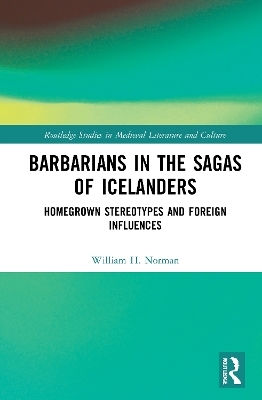
Barbarians in the Sagas of Icelanders
Homegrown Stereotypes and Foreign Influences
Seiten
2023
Routledge (Verlag)
978-1-032-04510-8 (ISBN)
Routledge (Verlag)
978-1-032-04510-8 (ISBN)
This book explores the way in the Sagas of Icelanders depict the barbarity of foreign peoples, both abroad and in Iceland, through descriptions of diet, material culture, style of warfare, and character, and compares the portrayal with classical and contemporary European ideas.
This book explores accounts in the Sagas of Icelanders of encounters with foreign peoples, both abroad and in Iceland, who are portrayed according to stereotypes which vary depending on their origins. Notably, inhabitants of the places identified in the sagas as Írland, Skotland and Vínland are portrayed as being less civilized than the Icelanders themselves. This book explores the ways in which the Íslendingasögur emphasize this relative barbarity through descriptions of diet, material culture, style of warfare and character. These characteristics are discussed in relation to parallel descriptions of Icelandic characters and lifestyle within the Íslendingasögur, and also in the context of a tradition in contemporary European literature, which portrayed the Icelanders themselves as barbaric. Comparisons are made with descriptions of barbarians in classical Roman texts, primarily Sallust, but also Caesar and Tacitus, showing striking similarities between Roman and Icelandic ideas about barbarians.
This book explores accounts in the Sagas of Icelanders of encounters with foreign peoples, both abroad and in Iceland, who are portrayed according to stereotypes which vary depending on their origins. Notably, inhabitants of the places identified in the sagas as Írland, Skotland and Vínland are portrayed as being less civilized than the Icelanders themselves. This book explores the ways in which the Íslendingasögur emphasize this relative barbarity through descriptions of diet, material culture, style of warfare and character. These characteristics are discussed in relation to parallel descriptions of Icelandic characters and lifestyle within the Íslendingasögur, and also in the context of a tradition in contemporary European literature, which portrayed the Icelanders themselves as barbaric. Comparisons are made with descriptions of barbarians in classical Roman texts, primarily Sallust, but also Caesar and Tacitus, showing striking similarities between Roman and Icelandic ideas about barbarians.
William H. Norman completed his PhD on the Sagas of Icelanders at the University of Cambridge, UK. He is interested in all aspects of characterization and worldview in the sagas and has published previously on the portrayal of Irish ancestry in the sagas.
Ancient Icelandic Other
Barbarians
Food and Diet from Iceland to Vínland
Prestige and Prejudice: Material Culture
The Barbarian’s Guide to Battle
Meeting the Other
Conclusions
Appendix: Barbarians in the Íslendingasögur
| Erscheinungsdatum | 16.03.2022 |
|---|---|
| Reihe/Serie | Routledge Studies in Medieval Literature and Culture |
| Zusatzinfo | 4 Tables, black and white |
| Verlagsort | London |
| Sprache | englisch |
| Maße | 152 x 229 mm |
| Gewicht | 453 g |
| Themenwelt | Geschichte ► Allgemeine Geschichte ► Mittelalter |
| Geschichte ► Teilgebiete der Geschichte ► Kulturgeschichte | |
| Geisteswissenschaften ► Sprach- / Literaturwissenschaft ► Anglistik / Amerikanistik | |
| Geisteswissenschaften ► Sprach- / Literaturwissenschaft ► Literaturwissenschaft | |
| ISBN-10 | 1-032-04510-8 / 1032045108 |
| ISBN-13 | 978-1-032-04510-8 / 9781032045108 |
| Zustand | Neuware |
| Informationen gemäß Produktsicherheitsverordnung (GPSR) | |
| Haben Sie eine Frage zum Produkt? |
Mehr entdecken
aus dem Bereich
aus dem Bereich
eine neue Geschichte des Mittelalters
Buch | Hardcover (2023)
C.H.Beck (Verlag)
CHF 53,20


